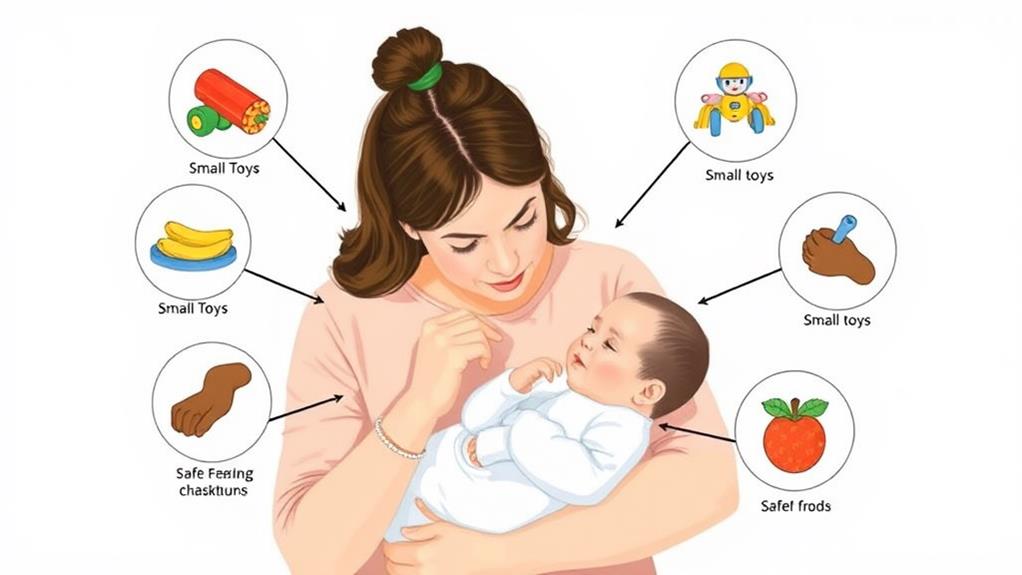If you're a new parent, the thought of your baby choking on breastmilk can be alarming. Various factors, like feeding position or milk flow, play a role in this risk. You might wonder what you can do to ensure a safe feeding experience for your little one. Understanding the signs of choking and knowing effective remedies can make a significant difference. So, what are the best techniques to prevent choking, and when should you seek further help? These are crucial questions that can guide you through this concern.
Understanding Choking Hazards

When it comes to feeding your baby, understanding choking hazards is crucial for their safety. Choking can happen unexpectedly, so being aware of the risks is your best defense. While breastmilk is generally safe, it's essential to recognize situations that could lead to choking incidents. For instance, if your baby is feeding while lying down or moving, the risk increases.
Always keep a close eye on your little one during feeding times. You might think it's just milk, but the way your baby swallows can change based on their positioning or distraction. If they're upset or fidgety, they may not swallow properly, leading to potential choking.
Also, remember that babies have different feeding needs as they grow. As they transition to solid foods, understanding the size and texture of what they consume becomes vital. Soft foods are usually safer, while hard or small items can pose significant risks.
Common Causes of Choking
During feeding times, several common causes of choking can arise, even with something as seemingly safe as breastmilk.
One major cause is the baby's feeding position. If your little one is too reclined, it can make swallowing more difficult, increasing the risk of choking. Additionally, if your baby is overly hungry or frustrated, they might gulp down milk too quickly, which can overwhelm their swallowing reflex.
Another factor is the flow of breastmilk. If your letdown is too forceful, it can send milk rushing into your baby's mouth, leading to choking. You might find it helpful to try different positions or to express some milk before feeding to manage the flow.
Also, distractions during feeding can cause your baby to suddenly pull away or move, making it harder to swallow. Keep the environment calm and quiet to help your baby focus on feeding.
Lastly, be aware of your baby's developmental stage. As they grow, they may start exploring things with their mouths, which can lead to accidental choking on small objects.
Understanding these common causes can help you create a safer feeding experience for your little one.
Signs Your Baby Is Choking

Choking can be a frightening experience for both you and your baby, so it's crucial to recognize the signs early. If your baby is having difficulty breathing, it might be a warning sign. Look for gasping or wheezing sounds, as these indicate that air is struggling to pass through.
You should also watch for a change in skin color; if your baby's lips or face turn blue or pale, this can signal serious distress.
Another sign to pay attention to is if your baby suddenly stops crying or making noise. This silence can be alarming, as it's often a sign that they're unable to breathe properly.
Additionally, if your baby's eyes widen or they appear panicked, these reactions often indicate fear or discomfort.
Observe your baby's hands and body movements too. If they're flailing or grabbing at their throat, it's a strong sign they're trying to indicate something's wrong.
Lastly, if your baby is unusually still and unresponsive, you need to act quickly. Being aware of these signs can help you respond promptly and ensure your baby's safety.
Importance of Proper Feeding Position
Recognizing the signs of choking is vital, but preventing it starts with the right feeding position. When you feed your baby, ensuring they're in a comfortable and safe posture can significantly reduce the risk of choking.
Holding your baby in a semi-upright position allows gravity to help the flow of milk, making it easier for them to swallow. This position also gives you better control over the feeding process, helping you notice any signs of discomfort or distress.
It's crucial to keep your baby's head higher than their stomach. This way, any excess milk won't flow back into their throat, which can lead to coughing or gagging.
You may also want to support their back and neck with your arm, providing them comfort and stability while they feed.
Techniques to Prevent Choking

To minimize the risk of choking while feeding your baby, it's essential to adopt several effective techniques.
First, always hold your baby in an upright position during feeding. This allows gravity to help the milk flow down smoothly, reducing the chances of it pooling in the throat.
Next, pay attention to the flow of milk. If you're breastfeeding, try to control the flow by adjusting your latch or taking breaks as needed. If you're using a bottle, choose one with a nipple that has a slow flow.
Another helpful technique is to maintain a calm feeding environment. Distractions can make your baby gulp or swallow too quickly, increasing the risk of choking. Keep the area quiet and free from sudden noises.
Also, it's good practice to watch for your baby's cues. If they seem to be struggling or are fussy during feeding, gently pause to allow them to catch their breath.
Lastly, make sure your baby isn't overly tired or hungry when it's feeding time. A relaxed and well-rested baby is less likely to rush through a feed and choke.
What to Do If Choking Occurs
Even with the best precautions, accidents can happen, and knowing how to respond when your baby chokes is vital. First, stay calm—your baby will sense your anxiety. If your baby is coughing or making sounds, let them try to clear the blockage on their own. Coughing can be effective, so don't interfere just yet.
However, if your baby turns blue, stops breathing, or can't make any noise, you'll need to act quickly. For infants under one year old, hold them face down on your forearm, supporting their head with your hand. Give up to five gentle back blows between their shoulder blades with the heel of your hand.
If that doesn't work, flip them over, and perform five quick chest thrusts using two fingers in the center of their chest, just below the nipples.
For older babies, you can use the Heimlich maneuver, which involves abdominal thrusts. Always call for help if you're unsure or if the situation doesn't improve.
When to Seek Medical Help

Your baby's safety is paramount, and knowing when to seek medical help after a choking incident can be crucial. If your baby shows signs of distress, like difficulty breathing, a weak cough, or turning blue, don't hesitate to call for help. These symptoms indicate that your little one may need immediate medical attention.
Even if your baby seems fine after a choking episode, it's smart to keep an eye on them. Watch for unusual behaviors, like excessive fussiness or lethargy, which could suggest lingering issues. If your baby starts vomiting or has trouble swallowing, these are also red flags that warrant a visit to the doctor.
Remember, you know your child best, so trust your instincts. If you're ever in doubt, it's better to err on the side of caution. You can always contact your pediatrician or go to the emergency room for peace of mind.
Being prepared and informed can make all the difference in ensuring your baby stays safe and healthy. Don't hesitate to reach out for help; your baby's well-being is worth it.
Breastfeeding Tips for Safety
After a choking incident, ensuring safe breastfeeding practices can help minimize risks for your baby.
First, always hold your baby in an upright position during feeding. This helps prevent milk from flowing too quickly and makes it easier for them to swallow. Make sure your baby's head is slightly elevated, which can aid in their comfort and safety.
Next, pay attention to your milk flow. If you're breastfeeding directly, you may need to adjust your position or take breaks if the flow feels too fast. If you're using a bottle, choose one designed to control the flow, so your baby isn't overwhelmed.
It's also a good idea to create a calm feeding environment. Reducing distractions helps your baby focus on feeding, making it less likely they'll gulp and choke.
Lastly, stay attentive and responsive to your baby's cues. If they seem uncomfortable or start to cough, gently pause and allow them time to recover.
Educating Caregivers on Choking Risks

Understanding choking risks is crucial for anyone caring for a baby. As a caregiver, you need to be aware that babies can choke, even on something as natural as breastmilk. This can happen if they gulp too quickly or if they're not properly positioned during feeding. It's essential to pay attention to your baby's cues. If they seem to be struggling or if you notice any unusual sounds, it's time to act.
Make sure to hold your baby in a semi-upright position while feeding. This helps minimize the risk of choking and promotes better swallowing.
Also, try to keep the feeding environment calm and distraction-free. A relaxed atmosphere allows your baby to focus on feeding, reducing the chances of gulping down air or milk too quickly.
Lastly, familiarize yourself with basic first aid for choking. Knowing what to do in an emergency can make all the difference. If your baby shows signs of distress, don't hesitate to seek immediate help.
Educating yourself about these choking risks not only protects your baby but also gives you peace of mind as you navigate the wonderful journey of caregiving.
Long-Term Strategies for Safe Feeding
Regularly implementing long-term strategies for safe feeding can significantly reduce the risk of choking in babies.
Start by choosing the right feeding position. Always hold your baby upright during feeding, whether you're breastfeeding or bottle-feeding. This position helps ensure milk flows smoothly and reduces the chance of aspiration.
Next, pay attention to your baby's cues. Let them guide the pace of feeding. If they seem overwhelmed or start to cough, pause and allow them to catch their breath.
It's also wise to take breaks during feedings. These pauses not only give your baby time to swallow but also help you monitor their comfort.
Another important strategy is to maintain a calm environment. Too much noise or excitement can distract your little one, making it harder for them to focus on feeding.
Lastly, keep up with regular pediatric check-ups. Your doctor can provide personalized advice and ensure your baby's feeding skills are developing appropriately.
